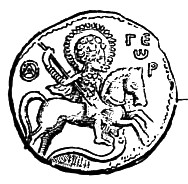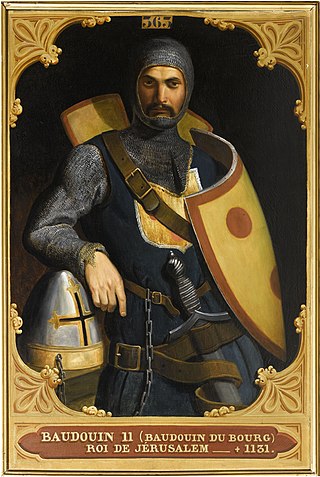Related Research Articles

Baldwin II, also known as Baldwin of Bourcq or Bourg, was Count of Edessa from 1100 to 1118, and King of Jerusalem from 1118 until his death. He accompanied his cousins Godfrey of Bouillon and Baldwin of Boulogne to the Holy Land during the First Crusade. He succeeded Baldwin of Boulogne as the second count of Edessa when he left the county for Jerusalem following his brother's death. He was captured at the Battle of Harran in 1104. He was held first by Sökmen of Mardin, then by Jikirmish of Mosul, and finally by Jawali Saqawa. During his captivity, Tancred, the Crusader ruler of the Principality of Antioch, and Tancred's cousin, Richard of Salerno, governed Edessa as Baldwin's regents.

In the Battle of Ager Sanguinis, also known as the Battle of the Field of Blood, the Battle of Sarmada, or the Battle of Balat, Roger of Salerno's Crusader army of the Principality of Antioch was annihilated by the army of Ilghazi of Mardin, the Artuqid ruler of Aleppo on 28 June 1119.
Joscelin I was a Frankish nobleman of the House of Courtenay who ruled as the lord of Turbessel, prince of Galilee (1112–1119) and count of Edessa (1118–1131). The County of Edessa reached its zenith during his rule. Captured twice, Joscelin continued to expand his county, even participating in the Battle of Azaz in 1125. Gravely injured during the collapse of a sapper mine, Joscelin marched his army to relieve the besieged fortress of Kaysun, and died soon after.

Pons was count of Tripoli from 1112 to 1137. He was a minor when his father, Bertrand, died in 1112. He swore fealty to the Byzantine Emperor Alexios I Komnenos in the presence of a Byzantine embassy. His advisors sent him to Antioch to be educated in the court of Tancred of Antioch, ending the hostilities between the two crusader states. Tancred granted four important fortresses to Pons in the Principality of Antioch. Since Pons held his inherited lands in fief of the kings of Jerusalem, Tancred's grant strengthened the autonomy of the County of Tripoli. On his deathbed, Tancred also arranged the marriage of his wife, Cecile of France, to Pons.

In the Battle of Azaz forces of the Crusader States commanded by King Baldwin II of Jerusalem defeated Aq-Sunqur al-Bursuqi's army of Seljuk Turks on 11 June 1125 and raised the siege of the town.
Abu Nasr Shams al-Muluk Duqaq was the Seljuq ruler of Damascus from 1095 to 1104.
Ridwan was a Seljuk emir of Aleppo from 1095 until his death.

Roger of Salerno was regent of the Principality of Antioch from 1112 to 1119. He was the son of Richard of the Principate and the 2nd cousin of Tancred, Prince of Galilee, both participants on the First Crusade. He became regent of Antioch when Tancred died in 1112; the actual prince, Bohemund II, was still a child. Like Tancred, Roger was almost constantly at war with the nearby Muslim states such as Aleppo. In 1114 there was an earthquake that destroyed many of the fortifications of the principality, and Roger took great care to rebuild them, especially those near the frontier.
Najm ad-Din Ilghazi ibn Artuq was the Turkoman Artukid ruler of Mardin from 1107 to 1122. He was born into the Oghuz tribe of Döğer.

Zahir al-Din Toghtekin or Tughtekin, also spelled Tughtegin, was a Turkoman military leader, who was emir of Damascus from 1104 to 1128. He was the founder of the Burid dynasty of Damascus.
Mawdud ibn Ahmed, also known as Sharaf al-Dawla Mawdûd, was an Arab military leader who was atabeg of Mosul from 1109 to 1113. He organized several expeditions to reconquer lands from the Crusaders and defeated them at the Battle of Al-Sannabra.

The timeline of the Principality of Antioch is a chronological list of events of the history of the Principality of Antioch.
Qasīm al-Dawla Sayf al-Dīn Abū Saʿīd Āqsunqur al-Bursuqī, also known as Aqsunqur al-Bursuqi, Aqsonqor il-Bursuqi, Aksunkur al-Bursuki, Aksungur or al-Borsoki, was the Seljuk Turkoman atabeg of Mosul from 1113–1114 and again from 1124–1126.
Robert fitz-Fulk the Leper, also known as Robert Fulcoy, Robert the Leprous, or Robert of Saone, was a powerful baron in the Principality of Antioch.
The siege of Aleppo by Baldwin II of Jerusalem and his allies lasted from 6 October 1124 to 25 January 1125. It ended in a Crusader withdrawal following the arrival of a relief force led by Aqsunqur al-Bursuqi.
Jawali Saqawa, also known as Chavli Saqaveh, was a Turkoman adventurer who was atabeg of Mosul from 1106–1109. In 1104, Jawali held Baldwin II as prisoner until he was ransomed in 1108. He had purloined Baldwin from Jikirmish of Mosul who, in turn, had taken him from Sökmen. Jawali was designated successor to Jikirmish by Muhammad I Tapar when he attacked and killed his predecessor, thus becoming atabeg in 1106, seizing Mosul and his hostage Baldwin. Joscelin I, himself ransomed in 1107, started negotiations with Jawali over the release of Baldwin. Jawali demanded a ransom and the release of Muslim prisoners from Edessa. Muhammad later was unhappy with the growing power of Jawali and dispatched Mawdud to unseat him. Expelled from Mosul, Jawali fled to the fortress of Qal’at Ja’bar, taking Baldwin with him. Jawali accepted a ransom offer by Joscelin and released Baldwin in the summer of 1108. Mawdud became atabeg of Mosul in 1109.
Luʾluʾ al-Yaya, also called al-Bābā or al-Khādim, was the regent of the Seljuk sultanate of Aleppo from AD 1113 until his assassination in 1117 (510). He was the atabeg (father-lord) of the underage sultans. Previously, he had been a eunuch in the service of Aqsunqur al-Bursuqī, the atabeg of Mosul.
Husam al-Din Timurtash was an Artuqid emir of Mardin (1122–1154) and ruler of Aleppo (1124–1125).
References
- ↑ رحمتی, محسن (March 2018). "خاندان برسقی و تحولات عصر سلجوقی" (PDF). پژوهش های تاریخی (in Persian). 10 (1). doi:10.22108/jhr.2017.83577.
- 1 2 3 4 Cahen 1969, p. 170.
- 1 2 Finck 1969, p. 403.
- 1 2 3 Lock 2006, p. 32.
- 1 2 3 4 Finck 1969, p. 404.
- 1 2 Barber 2012, p. 104.
- ↑ Lock 2006, p. 33.